Business Model Analysis: Volvo Group's Strategies and Perspectives
VerifiedAdded on 2023/06/13
|9
|2216
|317
Essay
AI Summary
This essay provides an in-depth analysis of Volvo Group's business model, focusing on its strategies for revenue generation and sustainable development. It examines the company's value proposition, resources, capabilities, and system of processes, highlighting the significance of its business model in the competitive automotive industry. The analysis incorporates the Osterwalder & Pigneur framework, SWOT analysis, and various business model perspectives to assess Volvo's current position and future opportunities. The essay also addresses the threats and opportunities arising from technological advancements and market dynamics, emphasizing the importance of innovation and strategic partnerships for Volvo Group's continued success and sustainability. The conclusion underscores the critical role of effective business models in achieving commercial sustainability and meeting customer demands.
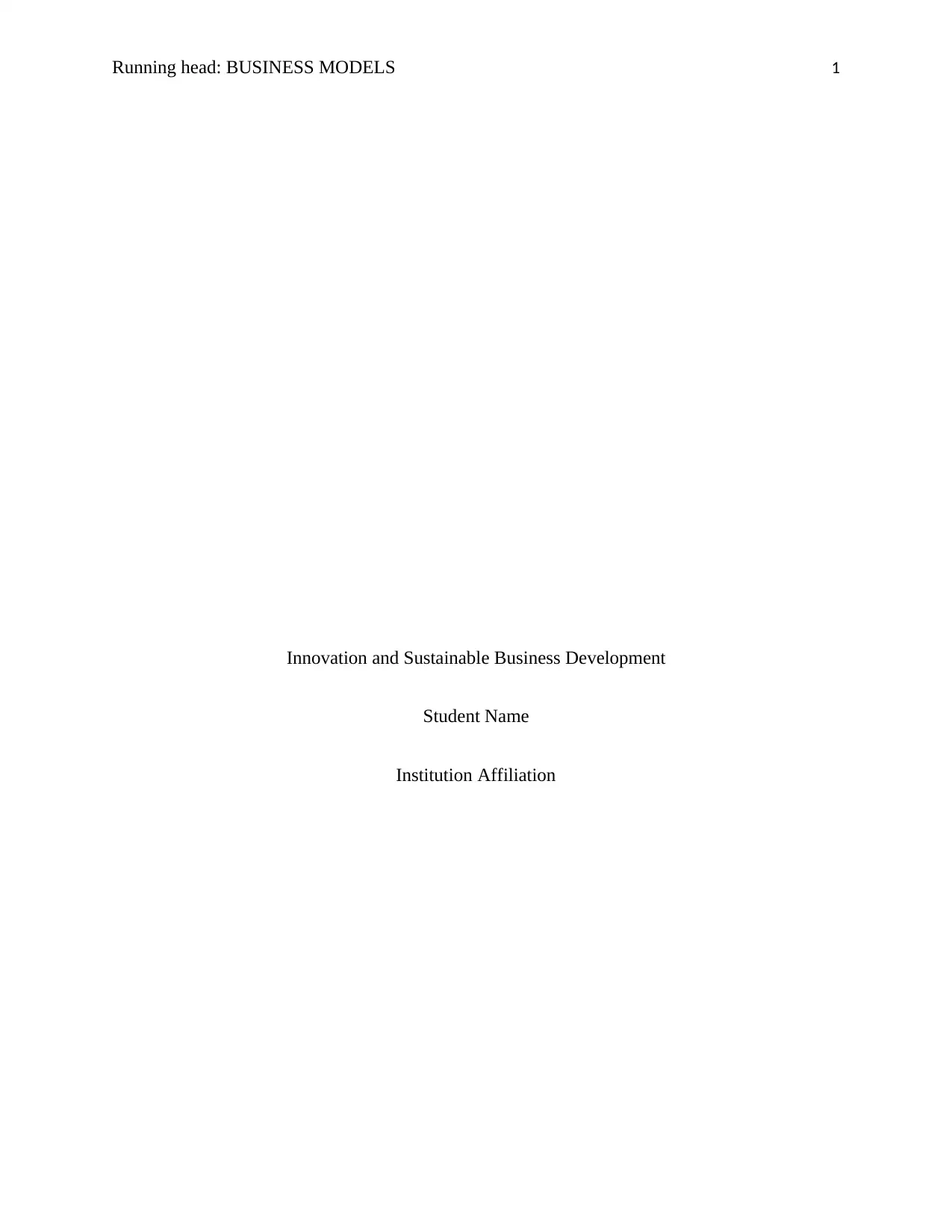
Running head: BUSINESS MODELS 1
Innovation and Sustainable Business Development
Student Name
Institution Affiliation
Innovation and Sustainable Business Development
Student Name
Institution Affiliation
Paraphrase This Document
Need a fresh take? Get an instant paraphrase of this document with our AI Paraphraser

BUSINESS MODELS 2
A business model entails the methods employed by a firm to earn the revenues projected
in its strategic plan. Business model views the business as a system and guides the management
on the best strategies of making money and enhancing its survival (Osterwalder & Pigneur,
2010). The creation of a business model involves the completion of business plans by
determining the right products to pursue. This assignment explains the business model of Volvo
Group, Sweden; manufacturer and service of trucks and construction equipment. In its business
model, the Volvo Group pursues the manufacturing of buses, trucks, construction equipment and
marine and industrial engines. Also, the Volvo Group offers clients with complete solutions for
financing and service. Due to the company’s great desire to achieve customer satisfaction, the
company has approximately 100,000 employees, production facilities in 18 nations, and
differentiates its product sales to over 190 global markets. In this essay, Volvo Group's business
model, its significance, value proposition, resources, SWOT, the system of processes and other
factors will be credibly analyzed.
Volvo Group has one of the best business models among all manufacturing companies in
the world. The management has a specialized department that maps out to create an ongoing
value for clients and customers interests (Palo & Tähtinen, 2011). Today, Volvo's success in the
market is contingent upon its excellent business model and how its crafting fits the target
audience and its market needs. The company has a diverse entrepreneurial competence in
conformity to what customers demand as well as the strategies of meeting these customer
demands to increase sales hence profitability (Kowalkowski, 2010). The use of business models
in Volvo Group aims at articulating the value proposition, target market segmentation
identification, defining the value chain structures, selecting the right technology and features and
enhancing a proper estimation of its cost structure and profit potentials in its operations into the
A business model entails the methods employed by a firm to earn the revenues projected
in its strategic plan. Business model views the business as a system and guides the management
on the best strategies of making money and enhancing its survival (Osterwalder & Pigneur,
2010). The creation of a business model involves the completion of business plans by
determining the right products to pursue. This assignment explains the business model of Volvo
Group, Sweden; manufacturer and service of trucks and construction equipment. In its business
model, the Volvo Group pursues the manufacturing of buses, trucks, construction equipment and
marine and industrial engines. Also, the Volvo Group offers clients with complete solutions for
financing and service. Due to the company’s great desire to achieve customer satisfaction, the
company has approximately 100,000 employees, production facilities in 18 nations, and
differentiates its product sales to over 190 global markets. In this essay, Volvo Group's business
model, its significance, value proposition, resources, SWOT, the system of processes and other
factors will be credibly analyzed.
Volvo Group has one of the best business models among all manufacturing companies in
the world. The management has a specialized department that maps out to create an ongoing
value for clients and customers interests (Palo & Tähtinen, 2011). Today, Volvo's success in the
market is contingent upon its excellent business model and how its crafting fits the target
audience and its market needs. The company has a diverse entrepreneurial competence in
conformity to what customers demand as well as the strategies of meeting these customer
demands to increase sales hence profitability (Kowalkowski, 2010). The use of business models
in Volvo Group aims at articulating the value proposition, target market segmentation
identification, defining the value chain structures, selecting the right technology and features and
enhancing a proper estimation of its cost structure and profit potentials in its operations into the
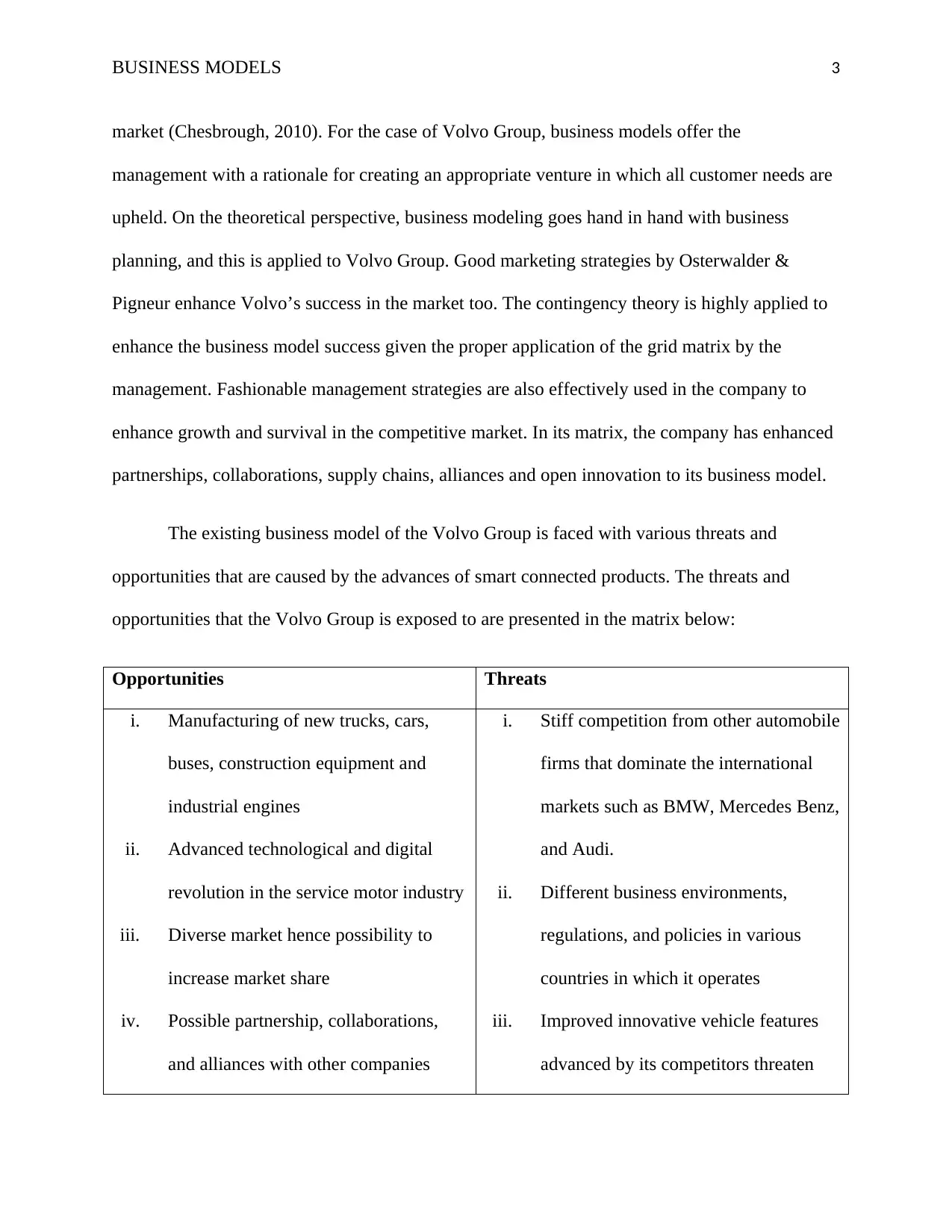
BUSINESS MODELS 3
market (Chesbrough, 2010). For the case of Volvo Group, business models offer the
management with a rationale for creating an appropriate venture in which all customer needs are
upheld. On the theoretical perspective, business modeling goes hand in hand with business
planning, and this is applied to Volvo Group. Good marketing strategies by Osterwalder &
Pigneur enhance Volvo’s success in the market too. The contingency theory is highly applied to
enhance the business model success given the proper application of the grid matrix by the
management. Fashionable management strategies are also effectively used in the company to
enhance growth and survival in the competitive market. In its matrix, the company has enhanced
partnerships, collaborations, supply chains, alliances and open innovation to its business model.
The existing business model of the Volvo Group is faced with various threats and
opportunities that are caused by the advances of smart connected products. The threats and
opportunities that the Volvo Group is exposed to are presented in the matrix below:
Opportunities Threats
i. Manufacturing of new trucks, cars,
buses, construction equipment and
industrial engines
ii. Advanced technological and digital
revolution in the service motor industry
iii. Diverse market hence possibility to
increase market share
iv. Possible partnership, collaborations,
and alliances with other companies
i. Stiff competition from other automobile
firms that dominate the international
markets such as BMW, Mercedes Benz,
and Audi.
ii. Different business environments,
regulations, and policies in various
countries in which it operates
iii. Improved innovative vehicle features
advanced by its competitors threaten
market (Chesbrough, 2010). For the case of Volvo Group, business models offer the
management with a rationale for creating an appropriate venture in which all customer needs are
upheld. On the theoretical perspective, business modeling goes hand in hand with business
planning, and this is applied to Volvo Group. Good marketing strategies by Osterwalder &
Pigneur enhance Volvo’s success in the market too. The contingency theory is highly applied to
enhance the business model success given the proper application of the grid matrix by the
management. Fashionable management strategies are also effectively used in the company to
enhance growth and survival in the competitive market. In its matrix, the company has enhanced
partnerships, collaborations, supply chains, alliances and open innovation to its business model.
The existing business model of the Volvo Group is faced with various threats and
opportunities that are caused by the advances of smart connected products. The threats and
opportunities that the Volvo Group is exposed to are presented in the matrix below:
Opportunities Threats
i. Manufacturing of new trucks, cars,
buses, construction equipment and
industrial engines
ii. Advanced technological and digital
revolution in the service motor industry
iii. Diverse market hence possibility to
increase market share
iv. Possible partnership, collaborations,
and alliances with other companies
i. Stiff competition from other automobile
firms that dominate the international
markets such as BMW, Mercedes Benz,
and Audi.
ii. Different business environments,
regulations, and policies in various
countries in which it operates
iii. Improved innovative vehicle features
advanced by its competitors threaten
⊘ This is a preview!⊘
Do you want full access?
Subscribe today to unlock all pages.

Trusted by 1+ million students worldwide

BUSINESS MODELS 4
reduced market share
iv. Unexpected problems and fluctuation in
exchange rates
The current era of technological revolution offers Volvo Group with numerous
opportunities to innovate new product designs that suit the current demand in the automobile
sector. The 100,000 employees of the company work in different departments in which the
company provides sufficient and appropriate resources that facilitate creativity and
innovativeness with the use of technology. New designs, models, and structures of cars have
been innovated (Kindström, 2010). Further, the company has been able to expand the size of
Volvo trucks resulting to the establishment of possible partnerships with other companies such as
Yokohama Tires. As a result, the company increases its market share and possibility to expand in
more global markets other than the already exploited 20 countries.
However, the company is threatened by other big players in the industry such as BMW
and Audi who have the financial power to invest huge capital just to compete out other upcoming
players in the automobile industry. High competition in the market makes the company adjust its
business modeling plan to fit in the level of technology advanced by other companies, and this is
costly to Volvo (Frow, Ngo, & Payne, 2014). In its business model, the company plans to exploit
all the market opportunities in the 20 countries and other target markets. The operation in
different countries exposes Volvo to financial risks due to exchange rates fluctuation witnessed
in different countries. Further, the business plans set to apply in different countries differ and are
subject to error since the business environments differ from one country to another (Gebauer,
Edvardsson, & Bjurko, 2010). There is a possibility that the norms, policies, and regulations
reduced market share
iv. Unexpected problems and fluctuation in
exchange rates
The current era of technological revolution offers Volvo Group with numerous
opportunities to innovate new product designs that suit the current demand in the automobile
sector. The 100,000 employees of the company work in different departments in which the
company provides sufficient and appropriate resources that facilitate creativity and
innovativeness with the use of technology. New designs, models, and structures of cars have
been innovated (Kindström, 2010). Further, the company has been able to expand the size of
Volvo trucks resulting to the establishment of possible partnerships with other companies such as
Yokohama Tires. As a result, the company increases its market share and possibility to expand in
more global markets other than the already exploited 20 countries.
However, the company is threatened by other big players in the industry such as BMW
and Audi who have the financial power to invest huge capital just to compete out other upcoming
players in the automobile industry. High competition in the market makes the company adjust its
business modeling plan to fit in the level of technology advanced by other companies, and this is
costly to Volvo (Frow, Ngo, & Payne, 2014). In its business model, the company plans to exploit
all the market opportunities in the 20 countries and other target markets. The operation in
different countries exposes Volvo to financial risks due to exchange rates fluctuation witnessed
in different countries. Further, the business plans set to apply in different countries differ and are
subject to error since the business environments differ from one country to another (Gebauer,
Edvardsson, & Bjurko, 2010). There is a possibility that the norms, policies, and regulations
Paraphrase This Document
Need a fresh take? Get an instant paraphrase of this document with our AI Paraphraser
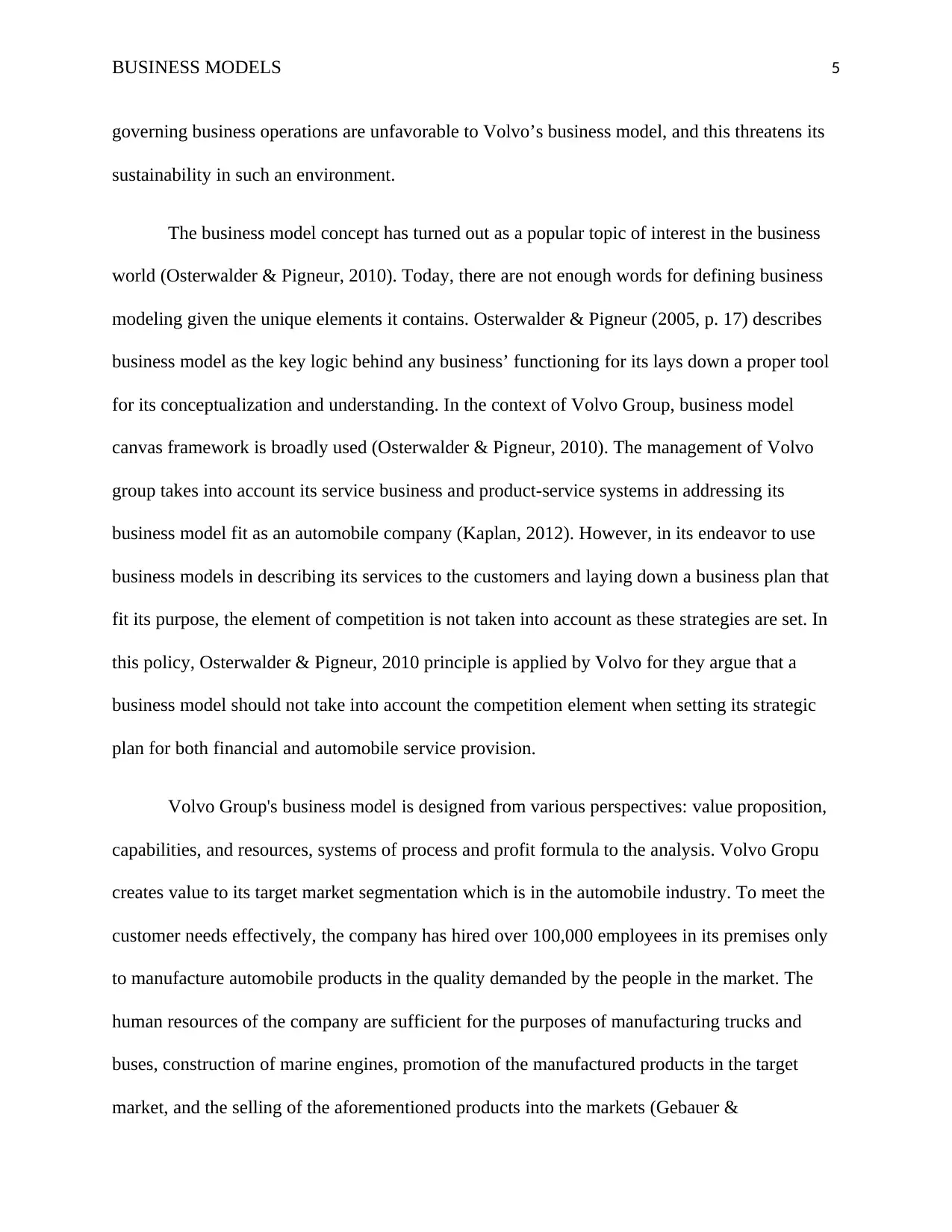
BUSINESS MODELS 5
governing business operations are unfavorable to Volvo’s business model, and this threatens its
sustainability in such an environment.
The business model concept has turned out as a popular topic of interest in the business
world (Osterwalder & Pigneur, 2010). Today, there are not enough words for defining business
modeling given the unique elements it contains. Osterwalder & Pigneur (2005, p. 17) describes
business model as the key logic behind any business’ functioning for its lays down a proper tool
for its conceptualization and understanding. In the context of Volvo Group, business model
canvas framework is broadly used (Osterwalder & Pigneur, 2010). The management of Volvo
group takes into account its service business and product-service systems in addressing its
business model fit as an automobile company (Kaplan, 2012). However, in its endeavor to use
business models in describing its services to the customers and laying down a business plan that
fit its purpose, the element of competition is not taken into account as these strategies are set. In
this policy, Osterwalder & Pigneur, 2010 principle is applied by Volvo for they argue that a
business model should not take into account the competition element when setting its strategic
plan for both financial and automobile service provision.
Volvo Group's business model is designed from various perspectives: value proposition,
capabilities, and resources, systems of process and profit formula to the analysis. Volvo Gropu
creates value to its target market segmentation which is in the automobile industry. To meet the
customer needs effectively, the company has hired over 100,000 employees in its premises only
to manufacture automobile products in the quality demanded by the people in the market. The
human resources of the company are sufficient for the purposes of manufacturing trucks and
buses, construction of marine engines, promotion of the manufactured products in the target
market, and the selling of the aforementioned products into the markets (Gebauer &
governing business operations are unfavorable to Volvo’s business model, and this threatens its
sustainability in such an environment.
The business model concept has turned out as a popular topic of interest in the business
world (Osterwalder & Pigneur, 2010). Today, there are not enough words for defining business
modeling given the unique elements it contains. Osterwalder & Pigneur (2005, p. 17) describes
business model as the key logic behind any business’ functioning for its lays down a proper tool
for its conceptualization and understanding. In the context of Volvo Group, business model
canvas framework is broadly used (Osterwalder & Pigneur, 2010). The management of Volvo
group takes into account its service business and product-service systems in addressing its
business model fit as an automobile company (Kaplan, 2012). However, in its endeavor to use
business models in describing its services to the customers and laying down a business plan that
fit its purpose, the element of competition is not taken into account as these strategies are set. In
this policy, Osterwalder & Pigneur, 2010 principle is applied by Volvo for they argue that a
business model should not take into account the competition element when setting its strategic
plan for both financial and automobile service provision.
Volvo Group's business model is designed from various perspectives: value proposition,
capabilities, and resources, systems of process and profit formula to the analysis. Volvo Gropu
creates value to its target market segmentation which is in the automobile industry. To meet the
customer needs effectively, the company has hired over 100,000 employees in its premises only
to manufacture automobile products in the quality demanded by the people in the market. The
human resources of the company are sufficient for the purposes of manufacturing trucks and
buses, construction of marine engines, promotion of the manufactured products in the target
market, and the selling of the aforementioned products into the markets (Gebauer &

BUSINESS MODELS 6
Kowalkowski, 2012). Further, in its business model; Volvo has shown capability in providing
complete solutions for financing and servicing of customers who want to acquire vehicles on a
loan based scheme. Also, the company has established excellent systems of processes that aid the
management in planning a series of actions within its computer systems to advance production
materials from one stage of completion to another (Nenonen & Storbacka, 2010). The Volvo
Group profit formula is also included in its business model and it seeks to increase profit making
and productivity of the company. The gross profit of the company is expressed as a ratio of gross
profit (GP) in terms of its net sales (GP/Net Sales).
The Volvo Group's Business model has a great significance to the company's future.
Business modeling opens a great chance for the company to enhance innovativeness in future
and compete out the well-positioned automobile companies in the world (Ulaga & Reinartz,
2011). Also, business model opens a future opportunity for Volvo to diversify its business
operations and partner with other global players hence improve productivity through automobile
service delivery. Further, the application of business model concept presents Volvo with tools for
solving sustainability issues hence increase profit making (Eriksson & Kovalainen, 2008).
Further, the company has a great opportunity of establishing reliable distribution channels,
supplies, and sales channels, as well as successful execution of business transactions. Today, the
company is rethinking its manufacturing and supply chain processes. The application of the right
business models will help the company increase its manufacturing capacity and service delivery
to customers hence enhancing overall success in the market.
In conclusion, companies that succeed in the generation of commercially sustainable
operations are those that invest in the application of the right business models. Excellent business
models play an important role in establishing key elements such as distribution channels and
Kowalkowski, 2012). Further, in its business model; Volvo has shown capability in providing
complete solutions for financing and servicing of customers who want to acquire vehicles on a
loan based scheme. Also, the company has established excellent systems of processes that aid the
management in planning a series of actions within its computer systems to advance production
materials from one stage of completion to another (Nenonen & Storbacka, 2010). The Volvo
Group profit formula is also included in its business model and it seeks to increase profit making
and productivity of the company. The gross profit of the company is expressed as a ratio of gross
profit (GP) in terms of its net sales (GP/Net Sales).
The Volvo Group's Business model has a great significance to the company's future.
Business modeling opens a great chance for the company to enhance innovativeness in future
and compete out the well-positioned automobile companies in the world (Ulaga & Reinartz,
2011). Also, business model opens a future opportunity for Volvo to diversify its business
operations and partner with other global players hence improve productivity through automobile
service delivery. Further, the application of business model concept presents Volvo with tools for
solving sustainability issues hence increase profit making (Eriksson & Kovalainen, 2008).
Further, the company has a great opportunity of establishing reliable distribution channels,
supplies, and sales channels, as well as successful execution of business transactions. Today, the
company is rethinking its manufacturing and supply chain processes. The application of the right
business models will help the company increase its manufacturing capacity and service delivery
to customers hence enhancing overall success in the market.
In conclusion, companies that succeed in the generation of commercially sustainable
operations are those that invest in the application of the right business models. Excellent business
models play an important role in establishing key elements such as distribution channels and
⊘ This is a preview!⊘
Do you want full access?
Subscribe today to unlock all pages.

Trusted by 1+ million students worldwide
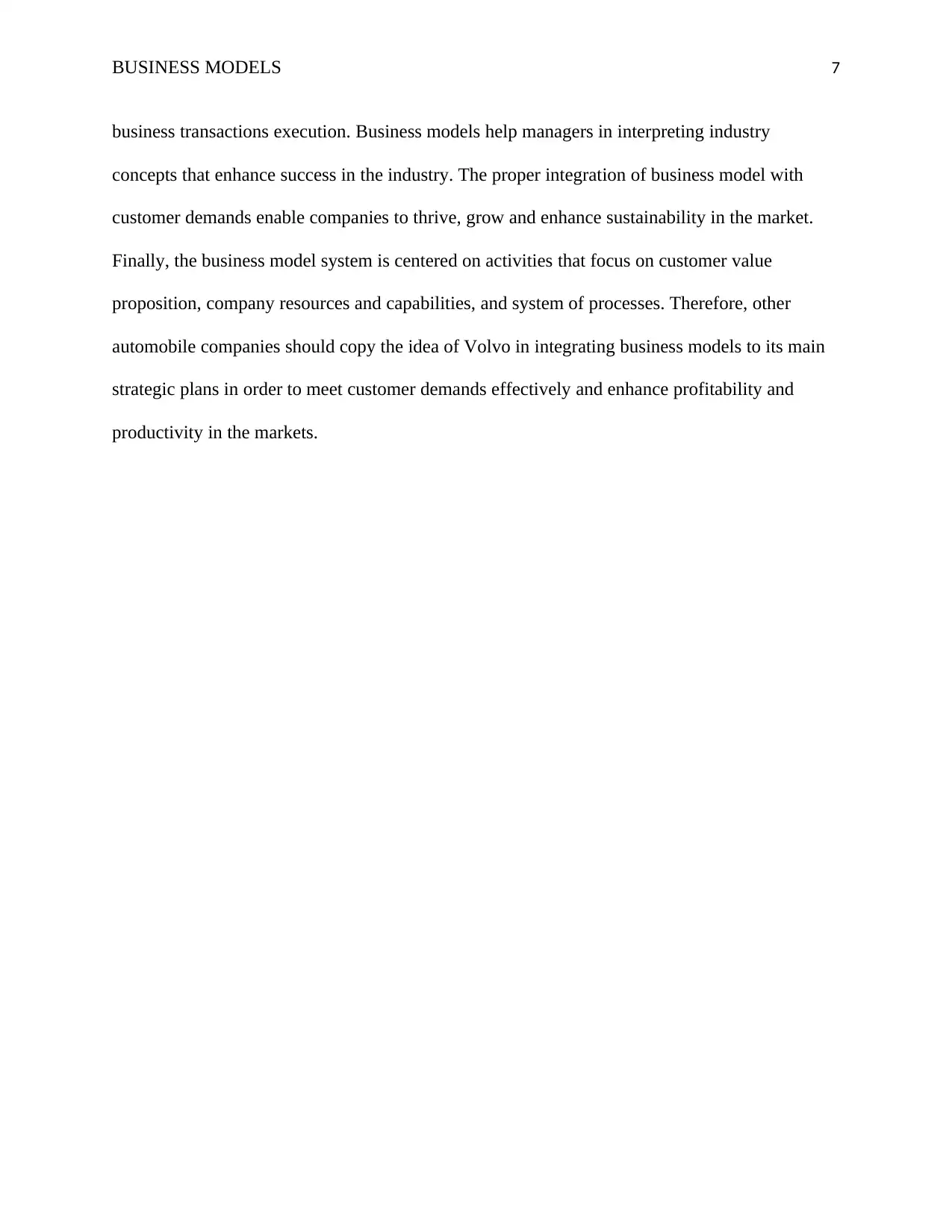
BUSINESS MODELS 7
business transactions execution. Business models help managers in interpreting industry
concepts that enhance success in the industry. The proper integration of business model with
customer demands enable companies to thrive, grow and enhance sustainability in the market.
Finally, the business model system is centered on activities that focus on customer value
proposition, company resources and capabilities, and system of processes. Therefore, other
automobile companies should copy the idea of Volvo in integrating business models to its main
strategic plans in order to meet customer demands effectively and enhance profitability and
productivity in the markets.
business transactions execution. Business models help managers in interpreting industry
concepts that enhance success in the industry. The proper integration of business model with
customer demands enable companies to thrive, grow and enhance sustainability in the market.
Finally, the business model system is centered on activities that focus on customer value
proposition, company resources and capabilities, and system of processes. Therefore, other
automobile companies should copy the idea of Volvo in integrating business models to its main
strategic plans in order to meet customer demands effectively and enhance profitability and
productivity in the markets.
Paraphrase This Document
Need a fresh take? Get an instant paraphrase of this document with our AI Paraphraser
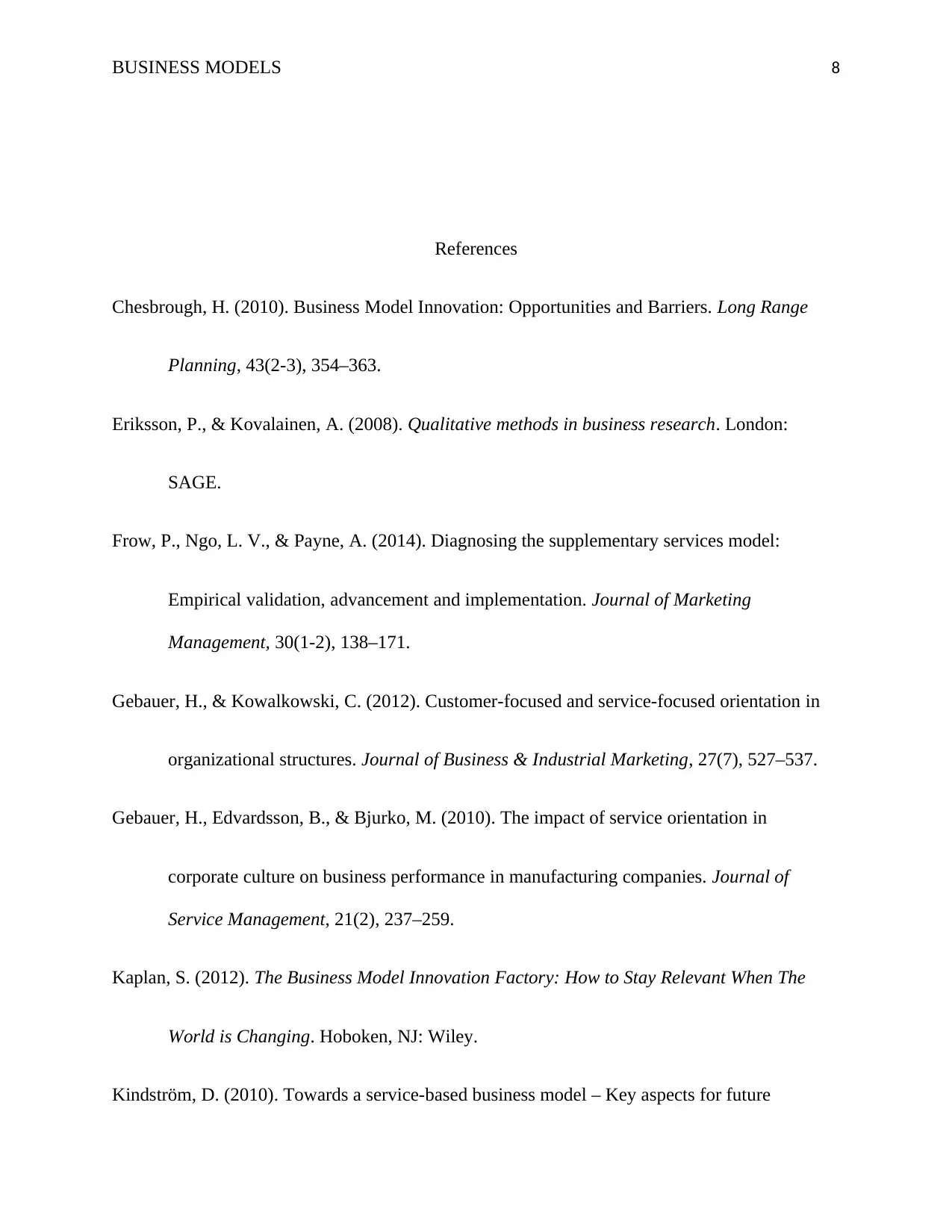
BUSINESS MODELS 8
References
Chesbrough, H. (2010). Business Model Innovation: Opportunities and Barriers. Long Range
Planning, 43(2-3), 354–363.
Eriksson, P., & Kovalainen, A. (2008). Qualitative methods in business research. London:
SAGE.
Frow, P., Ngo, L. V., & Payne, A. (2014). Diagnosing the supplementary services model:
Empirical validation, advancement and implementation. Journal of Marketing
Management, 30(1-2), 138–171.
Gebauer, H., & Kowalkowski, C. (2012). Customer-focused and service-focused orientation in
organizational structures. Journal of Business & Industrial Marketing, 27(7), 527–537.
Gebauer, H., Edvardsson, B., & Bjurko, M. (2010). The impact of service orientation in
corporate culture on business performance in manufacturing companies. Journal of
Service Management, 21(2), 237–259.
Kaplan, S. (2012). The Business Model Innovation Factory: How to Stay Relevant When The
World is Changing. Hoboken, NJ: Wiley.
Kindström, D. (2010). Towards a service-based business model – Key aspects for future
References
Chesbrough, H. (2010). Business Model Innovation: Opportunities and Barriers. Long Range
Planning, 43(2-3), 354–363.
Eriksson, P., & Kovalainen, A. (2008). Qualitative methods in business research. London:
SAGE.
Frow, P., Ngo, L. V., & Payne, A. (2014). Diagnosing the supplementary services model:
Empirical validation, advancement and implementation. Journal of Marketing
Management, 30(1-2), 138–171.
Gebauer, H., & Kowalkowski, C. (2012). Customer-focused and service-focused orientation in
organizational structures. Journal of Business & Industrial Marketing, 27(7), 527–537.
Gebauer, H., Edvardsson, B., & Bjurko, M. (2010). The impact of service orientation in
corporate culture on business performance in manufacturing companies. Journal of
Service Management, 21(2), 237–259.
Kaplan, S. (2012). The Business Model Innovation Factory: How to Stay Relevant When The
World is Changing. Hoboken, NJ: Wiley.
Kindström, D. (2010). Towards a service-based business model – Key aspects for future
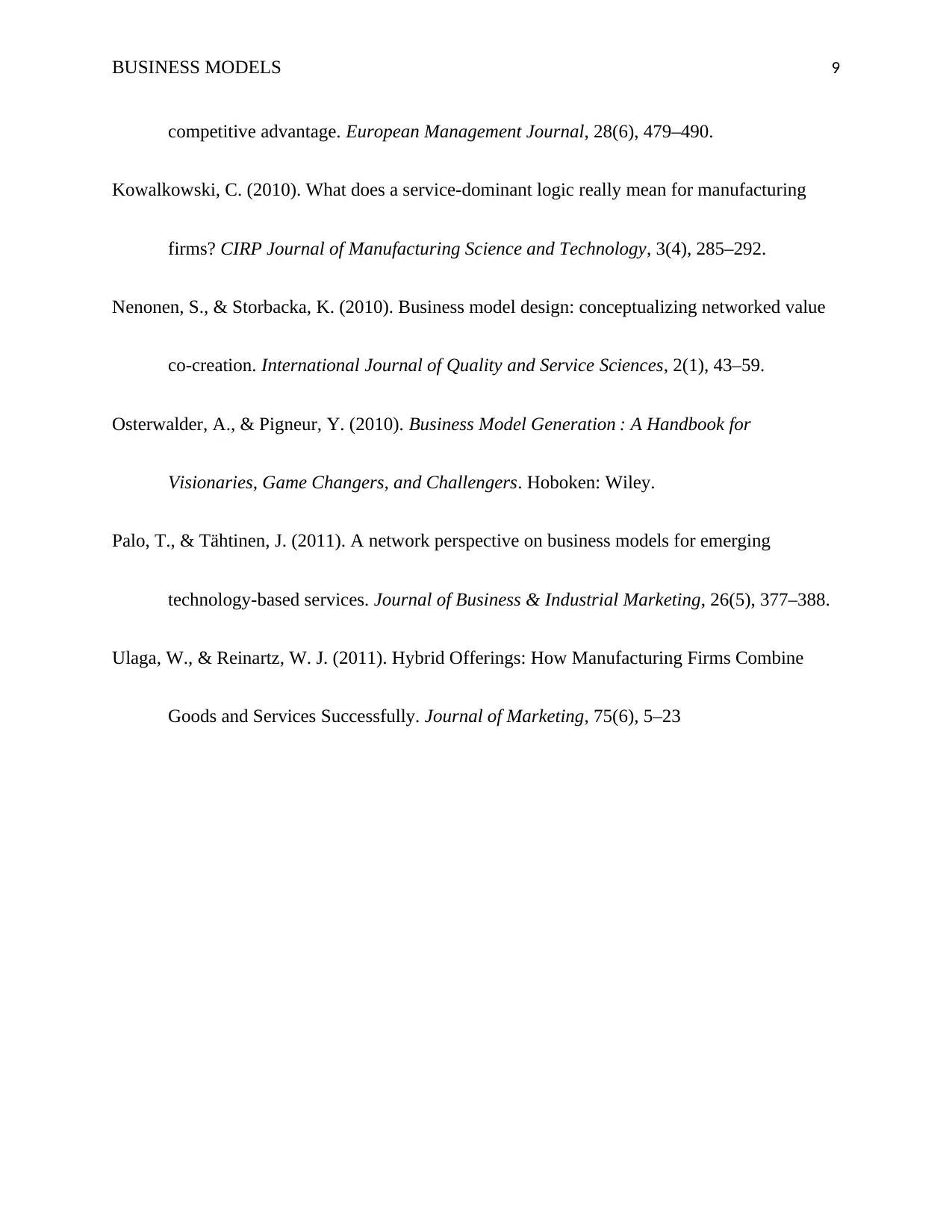
BUSINESS MODELS 9
competitive advantage. European Management Journal, 28(6), 479–490.
Kowalkowski, C. (2010). What does a service-dominant logic really mean for manufacturing
firms? CIRP Journal of Manufacturing Science and Technology, 3(4), 285–292.
Nenonen, S., & Storbacka, K. (2010). Business model design: conceptualizing networked value
co-creation. International Journal of Quality and Service Sciences, 2(1), 43–59.
Osterwalder, A., & Pigneur, Y. (2010). Business Model Generation : A Handbook for
Visionaries, Game Changers, and Challengers. Hoboken: Wiley.
Palo, T., & Tähtinen, J. (2011). A network perspective on business models for emerging
technology-based services. Journal of Business & Industrial Marketing, 26(5), 377–388.
Ulaga, W., & Reinartz, W. J. (2011). Hybrid Offerings: How Manufacturing Firms Combine
Goods and Services Successfully. Journal of Marketing, 75(6), 5–23
competitive advantage. European Management Journal, 28(6), 479–490.
Kowalkowski, C. (2010). What does a service-dominant logic really mean for manufacturing
firms? CIRP Journal of Manufacturing Science and Technology, 3(4), 285–292.
Nenonen, S., & Storbacka, K. (2010). Business model design: conceptualizing networked value
co-creation. International Journal of Quality and Service Sciences, 2(1), 43–59.
Osterwalder, A., & Pigneur, Y. (2010). Business Model Generation : A Handbook for
Visionaries, Game Changers, and Challengers. Hoboken: Wiley.
Palo, T., & Tähtinen, J. (2011). A network perspective on business models for emerging
technology-based services. Journal of Business & Industrial Marketing, 26(5), 377–388.
Ulaga, W., & Reinartz, W. J. (2011). Hybrid Offerings: How Manufacturing Firms Combine
Goods and Services Successfully. Journal of Marketing, 75(6), 5–23
⊘ This is a preview!⊘
Do you want full access?
Subscribe today to unlock all pages.

Trusted by 1+ million students worldwide
1 out of 9
Related Documents
Your All-in-One AI-Powered Toolkit for Academic Success.
+13062052269
info@desklib.com
Available 24*7 on WhatsApp / Email
![[object Object]](/_next/static/media/star-bottom.7253800d.svg)
Unlock your academic potential
Copyright © 2020–2025 A2Z Services. All Rights Reserved. Developed and managed by ZUCOL.





